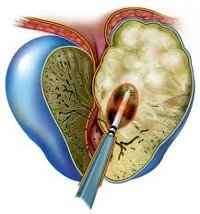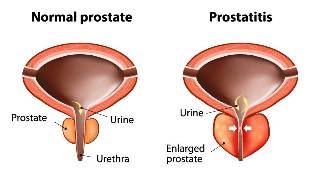Acute prostatitis is an infectious inflammation of the prostate gland, accompanied by swelling and the formation of purulent foci in the prostate. Manifestations of acute prostatitis depend on the stage (catarrhal, follicular, parenchymatous, abscessed) and may include dysuric disorders, pain in the perineum, fever, intoxication. Diagnosis is based on palpation of the prostate, ultrasound and Doppler studium prostate, study of discharge of the urethra and prostate secretion. Treatment of acute prostatitis includes the administration of antimicrobial therapy, NSAIDs, antispasmodics, analgesics, immunomodulators, physiotherapy.

Acute and chronic prostatitis are the most common and socially significant diseases of the male. In clinical urology, prostatitis is diagnosed in 30-58% of men in the reproductive and working age (30-50 years). For acute prostatitis is accompanied by disorders of sexual function and fertility, disorders of psychoemotional state and social disadaptation.
Causes of acute prostatitis
Causative agents of acute prostatitis are mainly non-infectious agents penetrate into the tissue of the prostate, the gram-negative (Escherichia coli, Klebsiella, Proteus) or gram-positive (staphylococci, enterococci, streptococci)
Often acute prostatitis may be caused by pathogens urogenital infections:
- chlamydia
- trichomoniasis,
- Ureaplasma,
- gonorrhea,
- mycoplasmosis,
- candidiasis etc.
Most often, the penetration of microbial agents in prostate tissue occurs transcanalicular way – through the excretory ducts of the glands which open into the rear wall of the urethra. Therefore, the urethritis of any origin is very often complicated with acute prostatitis. Less microbial flora gets into the prostate from the bladder in acute cystitis. The introduction of pathogens in the gland is significantly facilitated by the increased intraurethral pressure (reprehenderat, stones urethra), the conduct of the endourethral manipulation (bougienage of the urethra, urinary catheterization, ureteroscopy, cystoscopy, etc).
Additionally, acute prostatitis may result from hematogenous infection, facilitated by the conditions of the blood supply of the prostate with a well-developed system of arterial and venous anastomoses. When called hematogenous drift germs can get into the prostate tissue from distant foci in purulent tonsillitis, sinusitis, caries, cholecystitis, bronchitis, pyoderma, etc. May lymphogenous infection of the prostate from the bowel with anal fissures, proctitis, colitis.

To non-infectious factors contributing to the development of acute prostatitis include persistent congestion in the veins of the pelvis and disturbance of drainage acini of the prostate. Stagnation can be caused by disritmia sexuality and sexual disorders practice interrupted intercourse, lack of or irregular sexual activity, excessive sexual activity, etc. the Pathological deposition of blood in the venous line of the pelvis can be observed when sedentary lifestyle, frequent constipation, colds, chronic (mainly alcohol) intoxication, varicose veins of the pelvis.
Forms of acute prostatitis
In the development of acute prostatitis distinguish the following forms, which are its stages:
- catarrhal,
- follicular,
- parenchymal,
- abscessed.
Acute prostatitis begins with a catarrhal inflammation of the mucous and submucous layer of the excretory ducts of individual lobules of the gland. In further swelling of the walls of the ducts contributes to the stagnation of Muco-purulent secret in the follicles of the prostate and progression of inflammation, in connection with what may develop focal suppuration of lobules acute follicular prostatitis. When multiple lesions of lobules and diffuse involvement of the parenchyma and interstitial tissue of the prostate in suppurative inflammation, acute prostatitis passes to the next stage – parenchymal. In the case of a merger of small ulcers in the large hearth forming an abscess of the prostate gland, which may be opened in the urethra, perineum, rectum or bladder.
Symptoms of acute prostatitis
Clinical manifestations of acute prostatitis correspond to the stages of the process. Common manifestations are pain, disorders of urination and intoxication.
In the acute catarrhal stage of prostatitis feel the weight and pain in the perineum. Dysuric disorders is characterized by painful frequent urination, especially at night. Body temperature is maintained within the normal range, may be slightly elevated; intoxication missing. Palpation examination of the prostate is not changed or slightly increased, little painful. The study of prostate secretion detects an increase in white blood cells, the accumulation of Muco-purulent threads. In the urine during the emptying of the excretory ducts of the acini appear white blood cells. Prostate massage is usually impossible because of the pain. The treatment started in the catarrhal stage of acute prostatitis, leads to recovery in 7-10 days.
The follicular form of acute prostatitis occurs more brightly, accompanied by dull aching in the perineum, irradiating into the penis, rectum or sacrum. Against this background, the urination painful and difficult, until the development of acute urinary retention. The act of defecation in acute follicular prostatitis is also difficult because of the expressed pain. Due to the increase in body temperature to 38°C, impaired General condition. Palpation per rectum is determined is enlarged, dense, intense, asymmetric prostate, sharply painful in some areas when digital examination. Urine collected after palpation of the gland, contains a large number of leukocytes and purulent filaments, forming a turbid precipitate. Massage to obtain prostate secretion in the follicular phase of acute prostatitis is contraindicated. With vigorous treatment of acute follicular prostatitis can favorably be resolved; otherwise, it passes to the next, parenchymal phase.

Clinic of acute parenchymatous prostatitis develops rapidly. Characterized by severe hyperthermia (up to 39-39,5°C and above) with chills, General weakness, depression of appetite, thirst. First urination sharply learning and complicated, then may stop completely. Attempts to empty the bladder or bowel are accompanied by intense pain. Develop painful tenesmus, constipation, flatulence. The pain extends to the rectum, is of a throbbing character, forcing the patient to take a forced position – lying down with crossed legs. With the development of reactive inflammation of the rectum from the anus of mucus.
Determined by palpation diffusely enlarged, with unclear contours of the gland, extremely painful at the slightest touch. Prostate massage in parenchymal phase of acute prostatitis is strictly contraindicated. Sometimes because of a pararectal tissue swelling and tenderness, rectal examination is not possible to lead. In the urine – pronounced album sanguinem cellam, pyuria. The outcome of acute parenchymatous prostatitis can serve as resolution of the disease, formation of an abscess of the prostate or chronic prostatitis.
Diagnosis of acute prostatitis
The recognition and identification of the stage of acute prostatitis is performed by a urologist and is based on a comprehensive physical examination, laboratory and instrumental examination. Examination of the prostate through the rectum allows to determine the size, consistency, homogeneity, symmetry, cancer; pain reaction, foci of destruction, signs of purulent fusion of tissues. Palpation of the prostate in acute prostatitis is performed very carefully without rough pressure and massaging movements. Obtained in the prostate secretion revealed an increase in the number of leucocytes and amyloid Taurus, reducing the number of lecithin granules.
In acute prostatitis, there is increased leukocyturia in the third portion of urine and urine collected after palpation of the prostate. For allocation of the causative agent of acute prostatitis is necessary to conduct bacterial analysis of urine and urethral discharge with antibiotics, PCR studies of scrapings, blood cultures on sanguinem cultura. The nature and severity dysuric disorders in acute prostatitis is estimated using uroflowmetries.

Ultrasound of the prostate with moderate pain syndrome can be performed transrectal; in the case of pronounced pain reaction – transabdominal. Anoscopically estimated form, the magnitude of the cancer, the presence of focal or diffuse changes, it sets the stage of acute prostatitis. The use of Doppler studium allows a detailed and differentiated to evaluate the vascularization of the prostate.
When planning surgical tactics in relation to destructive forms of acute prostatitis are appropriate, CT or MRI of the pelvis.
Treatment of acute prostatitis
The leading role in the treatment of acute prostatitis belongs to the causal treatment. You need the earliest appointment antimicrobial (antibacterial, antiviral, antitrichomonal, antimycotic) drugs to suppress the reproduction of microorganisms in the gland and the tissues of the urethra. To reduce cramps and painful urination prescribe analgesics, spasmolytics, and rectal candles with Anaesthesinum or belladonna, heat microclysters. In complex therapy of acute prostatitis are used NSAIDs, enzymes, immunomodulators, vitamins, infusion solutions.
Physical therapy in acute prostatitis is performed after decrease in acute symptoms. With the aim of anti-inflammatory, decongestant, analgesic actions, improving microcirculation and local immunity applied rectal electrophoresis, UHF-therapy, microwave therapy, prostate massage. In acute prostatitis shown to comply with bed rest, sparing diet, sexual peace.
When urinary retention on the background of acute prostatitis avoid carrying out catheterization of the bladder, preferring trocar cystostomy. When abscess of the prostate occurs the need of surgical intervention - opening and drainage of the abscess cavity.
Of the cure of acute prostatitis is judged by the restoration of the structure of the tissue glands and its functions, the normalization of the composition of the juice of the prostate, elimination of pathogens causing the inflammation of body fluids.
Prognosis and prevention
As a rule, a timely and reasonable causal treatment leads to cupping of signs of acute prostatitis. The abscess of the prostate or chronic inflammation happens in advanced cases.
Prevention of acute prostatitis should include debridement of infectious foci in the body, carrying and endourethral endovesical manipulations in accordance with the rules of asepsis, timely treatment of STDs and urethritis, the normalization of sexual activity and physical activity.
























